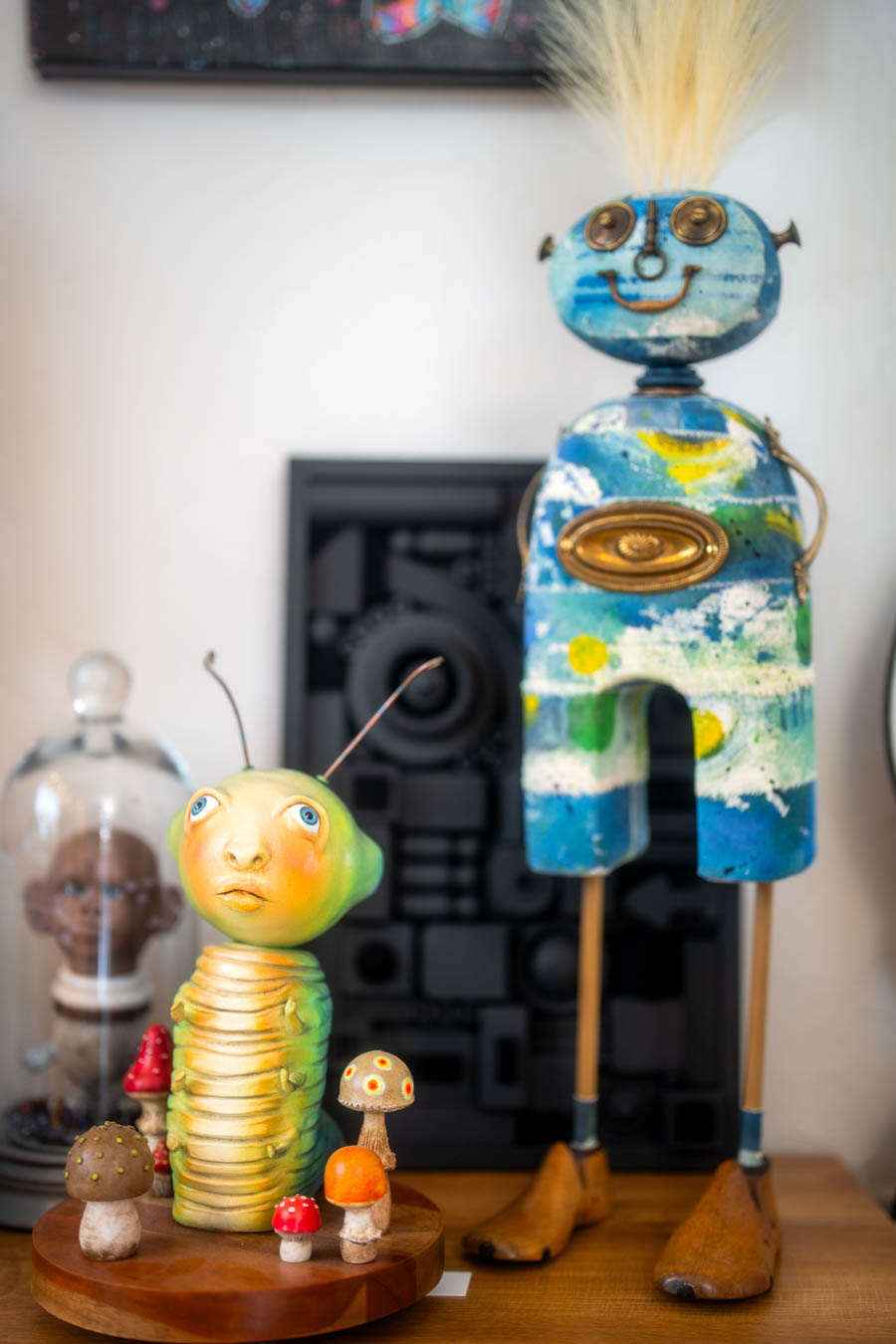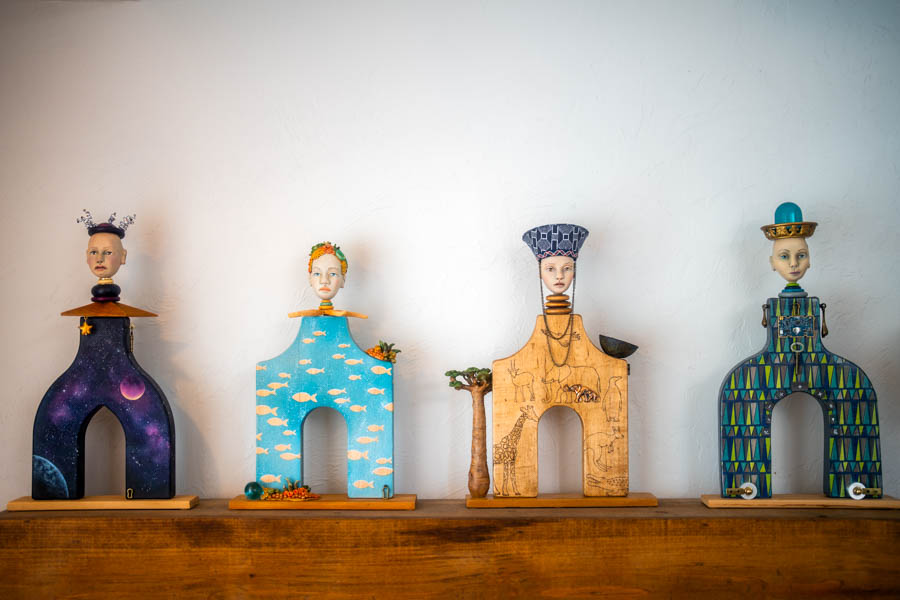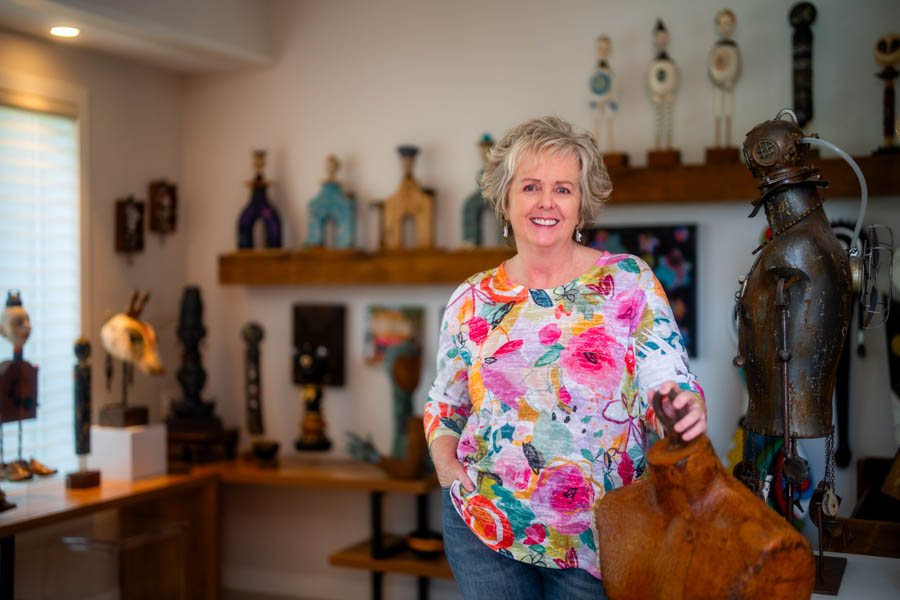Even she doesn’t know where they come from, this gaggle of strange children sprung forth from her imagination, like so many Athenas but in shapes ever more surprising. They come with animal heads on human bodies. They come mummified in canvas and rusted wire. They come unbidden, this patchwork progeny born of the disused and discarded, but undeniable nonetheless. And she builds them, sometimes as many as four at a time, as quickly as they can appear in her mind. Some come slowly, pieced together over years in the workshop, but none are ever abandoned. These are no Greek ideals but she loves them all the same. She gives them each names. And then she sells them. “Each one is like a puzzle,” Melanie Carlstein says. Softspoken with a shy smile and the sort of British accent that almost seems to apologize for all that colony business, one might half expect her to while away her days knitting or perhaps perfecting the art of the American casserole. But no. She’s somewhere in the workshop with a respirator strapped to her face, sanding some creature’s head into shape or searching the carefully curated chaos of her stores for the perfect widget or thingamajig to complete her latest creation. She knows it’s in there somewhere, waiting to be found amidst the endless wooden shelves and plastic containers full of everything from junk metal and old cabinetry hardware to boxes full of doll hands and that weird thing she found on the road that one time. Such is the life of an assemblage artist, where nothing is only what it seems and everything has the potential to be something new.
This includes the artist. Absent any formal training, Carlstein came to art late in life. She still insists she doesn’t know how to draw. “I don’t have a sketchbook and I don’t draw things down,” she says. “I just start working.” With no particular plan in mind, she approaches the enterprise almost like stream-of-consciousness sculpting, feeling her way to that eureka moment when it all comes together. Moving by this instinct, Carlstein is also never constrained to any one medium—and doesn’t understand the notion, espoused by some, that she’s supposed to stick with just one. “I just enjoy making stuff and I get bored doing the same thing,” she says. And so she’ll move as easily from sculpting with quick-drying clay that she can easily carve, sand, drill and paint to playing around with taxidermy foam before wrapping it in canvas and strangling it in rusty wire to create the perfect patina. There was even a particularly punk rock period, early on, when she’d just tear apart some old dolls and staple their vaguely haunted-looking Victorian heads onto strange and limbless bodies of her own creation. But this artistic phase is unlikely to return, after repeated feedback that danced around the word ‘creepy,’ if not saying it outright. “And I could see why they were saying that,” Carlstein admits, though a bit reluctantly. “But I don’t really care. I love them.”

Her only rule is that she wants to work quickly—and always start with the head. Done decapitating dolls, Carlstein crafts all the heads herself these days, finding the process key to discovering the personality and character of whatever she’s creating. And only after the head is complete will she go on the scavenger hunt through her workshop to find all those pieces that have been waiting patiently for their chance to be the perfect fit. “It’s giving these things a new lease on life,” she says. “Creating a new piece of art from, essentially, people’s trash.” Dominating the workbench these days is great slab of wood rescued from a barn in Massachusetts. It was once possibly a foundry mold, but Carlstein took one look and knew it was a bird. Or maybe a fish. It can be difficult to tell at this stage. It lies under the lights like a patient on the operating table while Carlstein experiments with different approaches, moving pieces, seeing how they fit. Testing. Retesting. Removing. Replacing. She builds an eyeball of washers and other assorted metal doodads and plops it into place. She seems satisfied. “I just sit here and play,” she says.
Everybody asks where the ideas come from—this writer included—but and despite years at play in her workshop of second chances, she has no satisfactory answer. But the same instinct that leads Carlstein to see a running dog where others see a shapeless puddle drives her to collect all of these things, hoarding them away with almost a moral necessity, just as it drives her to reassemble them into figures and shapes she never saw coming. Because through the eyes of the assemblage artist, the world is not what it appears to be and everywhere lay unrealized promise. Everything lives in the process of becoming—if only in need of a little help from the artist’s hand. And their imagination. Among all the arts, it is perhaps the one most predicated on an act of faith.

Sometimes that faith isn’t rewarded for years, as is the case for a small collection of salvaged metal and wood heaped to one side of the studio, a strange embryo that Carlstein insists will one day be an ostrich—and pulls out a hand-sculpted head and neck to prove it—as soon as she figures out the proper way to make feathers without feathers. “It’s a search,” she says. “But I love finding the right piece. That moment.” She pauses to play with the unbuilt ostrich. “Some fit right away; others take their damn time. But I’m determined to do it.”
Therein lies the inherent optimism in the work. A belief, almost romantic, that everything has its place and that every piece matters. That everything deserves new life and even something once discarded can be part of something made with love.









